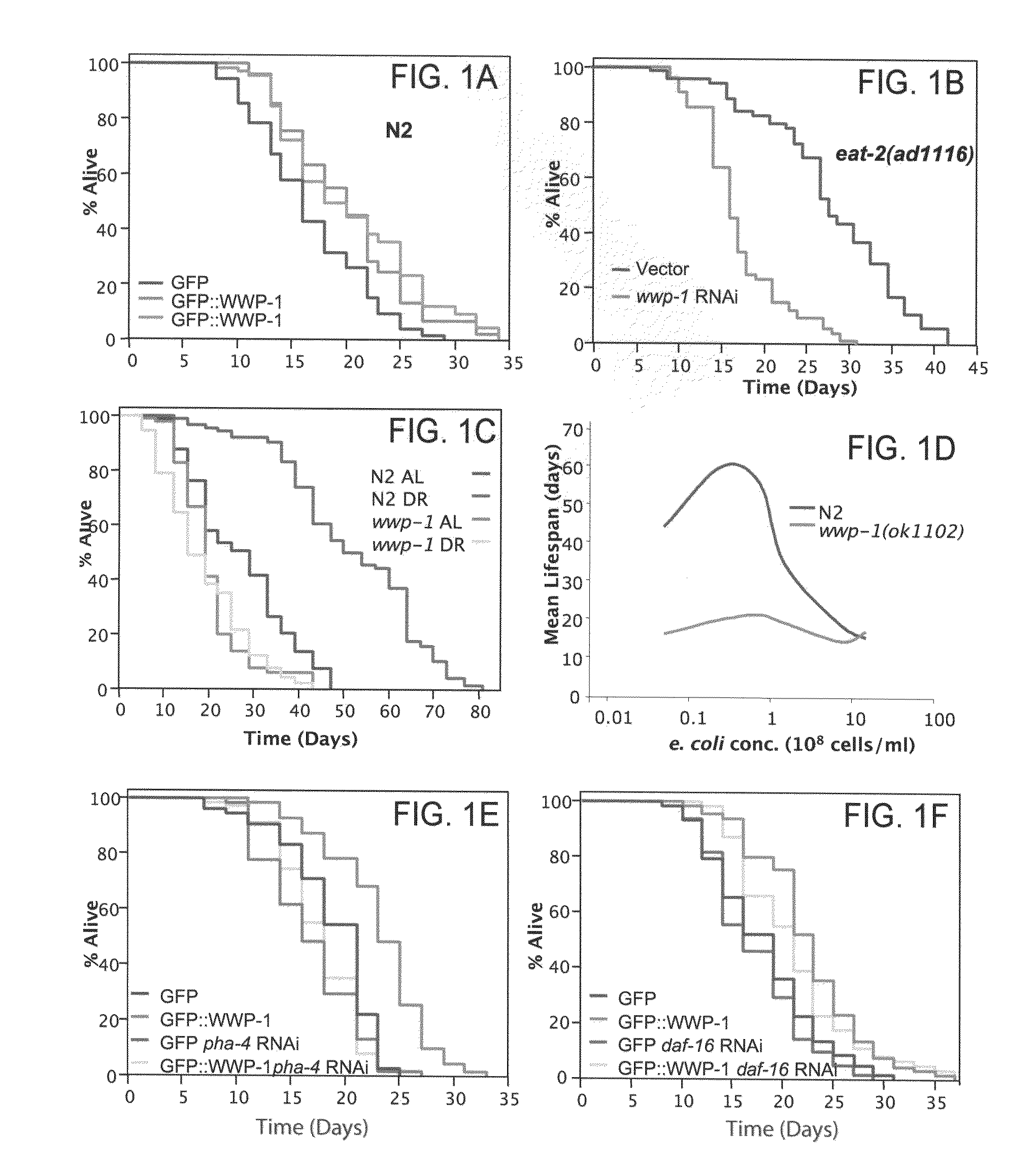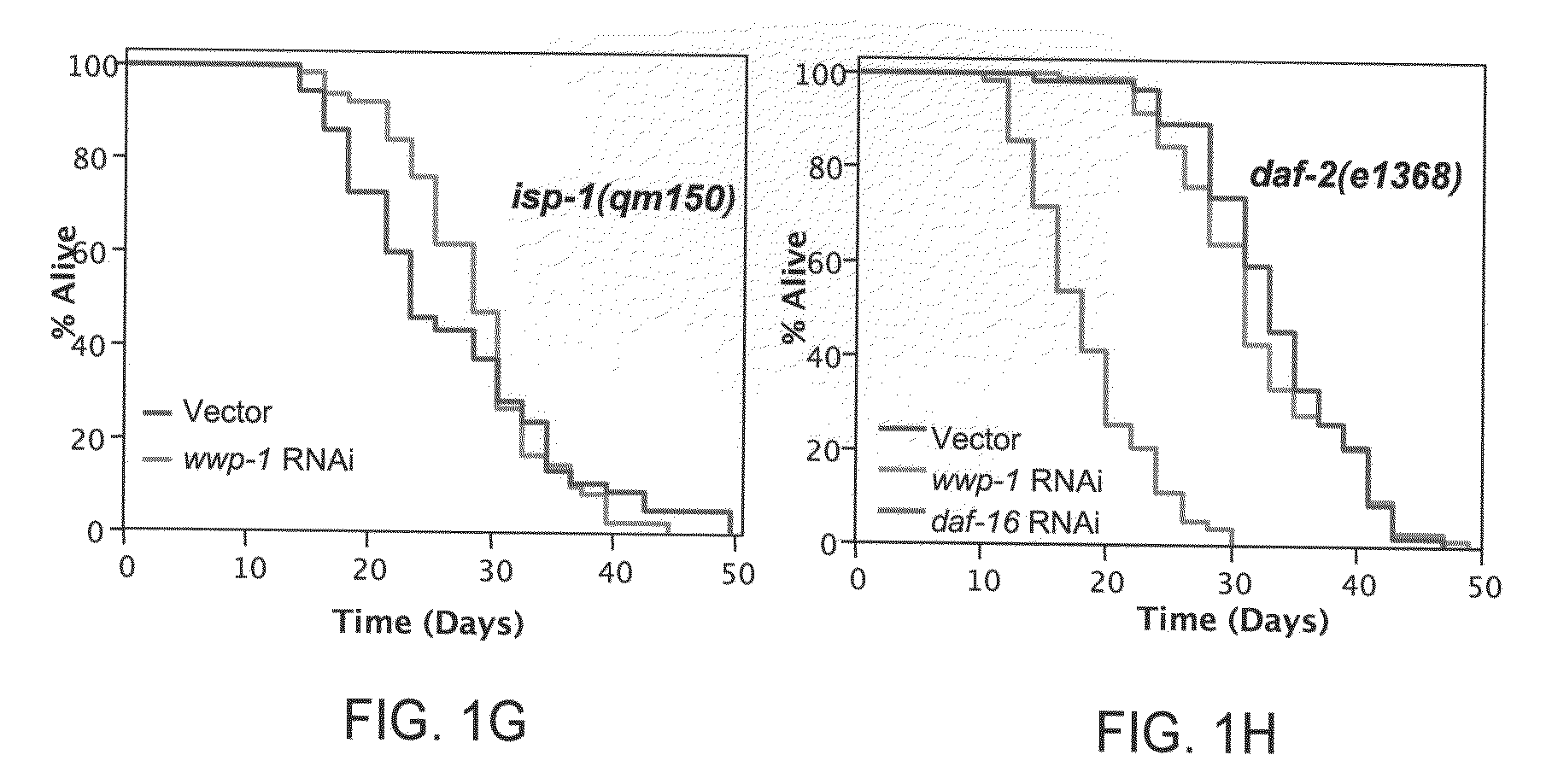Increasing lifespan by modulation of WWP-1 and UBC-18
a technology of ubc-18 and wwp-1, which is applied in the field of prolonging the life of animals, can solve the problems of affecting aging in mammals or other animals can have profound negative effects on the cognitive and motor functions of subjects, and increase the lifespan of a wide variety of metazoans, so as to achieve the effect of increasing the longevity of an animal
- Summary
- Abstract
- Description
- Claims
- Application Information
AI Technical Summary
Benefits of technology
Problems solved by technology
Method used
Image
Examples
example 1
The HECT E3 Ligase WWP-1 and the E2 UBC-18 Regulate Longevity Via Dietary Restriction in C. elegans
[0253]When diet is restricted (Dietary Restriction or DR), lifespan is extended in diverse species suggesting that there is a conserved mechanism for nutrient regulation of aging. How DR life extension occurs has not previously been clear. We present results herein that uncover a role for the HECT E3 ubiquitin ligase WWP-1 as a lifespan regulator in C. elegans. We find that overexpression of wwp-1 in worms can extend their lifespan by 20%. Our studies identify wwp-1 as an essential regulator of DR-induced longevity. Reduction of WWP-1 levels by dsRNA (double-stranded RNA) treatment completely suppressed the extended longevity of eat-2 mutant animals. In addition, the lifespan of wwp-1 mutant animals grown under true DR conditions was not extended. Overexpression of a mutant form of WWP-1, lacking catalytic activity as a result of mutation of the conserved catalytic cysteine in the HEC...
example 2
WWP-1 and UBC-18 Regulate Dietary Restriction-Induced Autophagy Involved in Lifespan Extension
[0360]Autophagy is an important eukaryotic response to cellular stress / nutrient limitation. In this process, portions of the cytoplasm and cytoplasmic organelles are degraded, allowing cellular macromolecules to be catabolized and recycled. Large double-membrane vesicles (autophagosomes) are generated and, along with their contents, degraded in lysosomes. The process of autophagy allows an animal to recycle macromolecules during times of starvation and stress to deploy scarce resources in a more beneficial fashion.
[0361]How autophagy is regulated has been studied extensively in yeast. Autophagy in yeast is controlled by ATG (autophagy regulated genes), most of which are highly conserved and have functional homologs in higher organisms. Briefly, TOR (Target Of Rapamycin) inhibits the protein kinase ATG1, which would otherwise mediate an early activation step in the autophagic process. In res...
PUM
| Property | Measurement | Unit |
|---|---|---|
| molecular weight | aaaaa | aaaaa |
| pH | aaaaa | aaaaa |
| pH | aaaaa | aaaaa |
Abstract
Description
Claims
Application Information
 Login to View More
Login to View More - R&D
- Intellectual Property
- Life Sciences
- Materials
- Tech Scout
- Unparalleled Data Quality
- Higher Quality Content
- 60% Fewer Hallucinations
Browse by: Latest US Patents, China's latest patents, Technical Efficacy Thesaurus, Application Domain, Technology Topic, Popular Technical Reports.
© 2025 PatSnap. All rights reserved.Legal|Privacy policy|Modern Slavery Act Transparency Statement|Sitemap|About US| Contact US: help@patsnap.com



